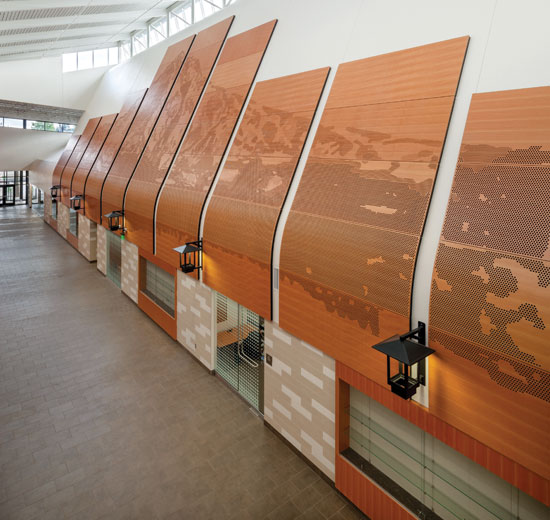Natural Winner: Western Red Cedar and Nonresidential Building
Specifying Western Red Cedar for a School
Having looked at examples of buildings whose original western red cedar exteriors had stood the test of time, the team at DOWA-IBI was confident that they could achieve the desired look without burdening the local school district. In fact, they considered the facility's timber exterior to be one of its long-lasting, low-maintenance building products, which would require little if any annual maintenance. Among the reasons is the wood's low density and minimal shrinkage factor, which improve the dimensional stability of the slats, boards and timbers. This means the members lie flat and remain straight after installation and hold fasteners solidly for years after construction.
The façades' durability also stem from western red cedar's natural resistance to moisture, decay and insect damage. “Western red cedar fibers in the heartwood contain natural preservatives that are toxic to decay-causing fungi,” says WRCLA's Mackie, who consulted to the project. “The two principal extractives that are responsible for the decay resistance are Thujaplicans and water-soluble phenolics.” He adds that a western red cedar tree's ability to produce these extractives increases with age, making the outer regions of heartwood the most durable.
According to DOWA-IBI's Waters, one of the key decisions to maximizing durability and minimizing maintenance was to treat the western red cedar with bleaching oil to accelerate the aging process and give the timber the grey, weathered appearance that has become associated with the Cascadian style—and as opposed to the honey color of stained western red cedar. Waters explains that WRCLA was helpful in providing information about treating the wood with bleaching oil and setting up that operation for their construction project.
 |
The interior of Sandy High School displays a mural of Mount Hood made of western red cedar. Photo by Josh Partee |
The low density of western red cedar, which helps provide its “exceptional thermal insulation value,” says Mackie, as well as the “natural preservatives that resist moisture, decay and insect damage,” were calculated into the decision to specify the species. The DOWA-IBI's envelope design further built upon these capabilities by including an air cavity behind the building's skin, which provides ventilation and keeps the enclosure dry.
Much of the western red cedar used for the project came from Idaho and Canada, says Steve Schellhase, president of Portland-based Time Frame, Inc., which framed and sided the Sandy High School building. The amount of western red cedar required to build the school precluded contractors from using materials sourced from certified forests, he said. On the project site, one of the big challenges for Schellhase was the heavy timber framing required for the enclosure massing, including its sawtooth roof and shade-giving 12-foot overhangs and louvers. Each western red cedar column comprises four, 8-by-8-inch cedar posts, supporting double 8-by-18-inch beams and double 8-by-16-inch rafters, all of which run in tandem.









